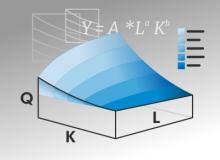Natural Resources
Everything about natural resources
Energy and resource limits are now inhibiting growth
Cover Story 3/4

The end of economic growth has been predicted repeatedly throughout the past 250 years, but never before has it been a present reality. Quite the contrary, whoever cried wolf was later defeated by further growth. These (sometimes premature) warnings might have added to the effect that, today, hardly anybody is listening.
But now, the situation is different, as growth is ending nearly everywhere despite our frantic attempts at reviving it, and economic limits are becoming a real threat for a growing number of people on our planet. Unless a miracle changes that trajectory, this won't go away, but will only accelerate.

Why is that so? If we wanted to meet even the modest target of 2% global economic growth per annum for the next 35 years, by the year 2050, we would have to double our resource consumption from today. Instead of using around 82 billion metric tons in 2015, we would consume about 164 billion tons in 2050. Total energy consumption, if improved at the recent rate of 0.3% p.a., would grow by 90% from today's 13,147 MTOE to around 25,000 MTOE. And if we keep introducing renewable energy at the pace of the past 10 years, fossil fuel consumption would grow by 85%, reducing the share of fossil fuels from 86% in 2014 to only around 83-84% in 2050.
All this assumes we will improve our resource and energy efficiency at the same rate as we did recently, we don't report paper growth, and no miracle breakthrough in energy occurs. We are aware of all those very ambitious objectives to improve global energy and resource efficiency, but so far, there are no indications these breakthroughs are happening - and can happen without affecting economic growth.
However, there are three key developments that make it almost impossible to ever get to the point of doubling the global economy by 2050: the diminishing marginal productivity of new resource exploration, limits on economic benefits of consumption, and credit limits.
Marginal resource productivity is declining
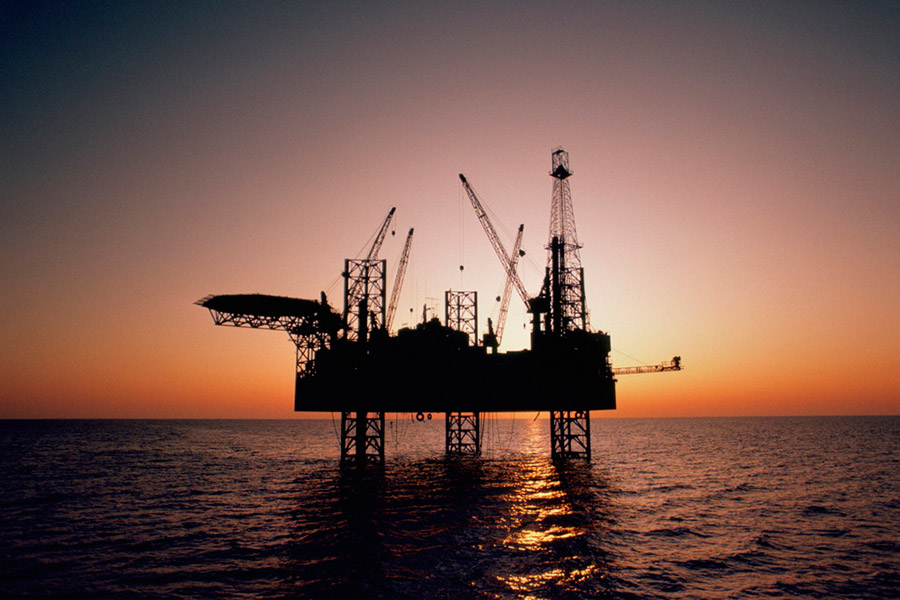
When extracting fossil energy and other natural resources, we don't really pay for everything that makes them available to us. We don't pay for the geological processes that have concentrated and enriched minerals in a way that makes it affordable to unearth them, and we don't pay for most of the damage we do when mining them, nor the damage we create when we dispose of waste. We primarily pay for finding, extracting, enriching, and transporting them to their point of final use. But on all these fronts, we are fighting an uphill battle. Extracting oil from the ocean in reservoirs up to 30,000ft deep is obviously more difficult than drilling a hole on land, where oil just seeps from rocks close to the surface, and mining copper from deposits that contain only a tiny fraction of the shiny metal makes us move and crush much more rock, and create much more landscape damage. Numerous examples exist, where we increase the effort to get additional, less rich mines and fields into production.
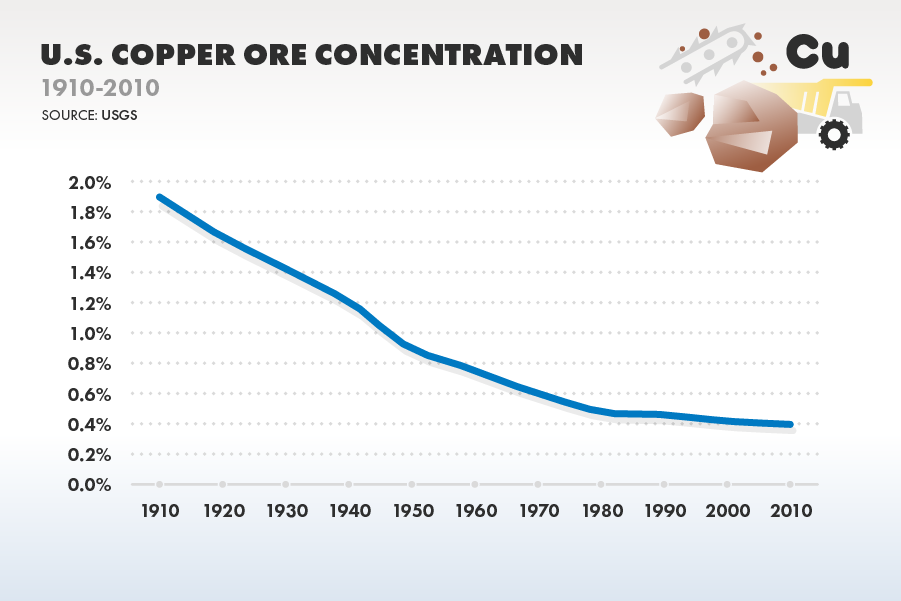
To stick with copper: In 2015, global copper was produced from ores with 0.65% copper content, an all-time low. In U.S. mines, ore grades are even lower at around 0.4%. The more we want to extract, the more effort is needed to tap into lower quality marginal sources, which reduces economic benefits.
How small or big those benefits become from using natural resources largely depends on the effort required to obtain them. The more we have to invest into getting the inputs, the less will be left for running the "machine" of industrialized societies. With increasingly lower marginal benefits from newly mined sources, our economies are bound to become smaller, not bigger.
Consumption reduces resource benefits
Fossil fuels and their usability to convert high-quality natural resources into useful goods has enabled our current lifestyle. To imagine the process we have been experiencing, we can use the analogy of invisible "helping hands" assisting us in whatever we do. Just like a draft animal uses additional solar energy from grazing to help improve crop output on a farm, a machine doing work for us in a factory channels past solar energy (in the form of fossil fuels) to support a lifestyle we could never accomplish with our bare hands or the help of a mule.
During the first 200 years after the industrial revolution, many of those benefits went into the creation of infrastructure that truly furthered growth. Machines, factories, railroads, roads, telecommunications networks, better housing for everyone, better hospitals and schools were investments into the ability to create more economic output. During the past decades, though, we have increasingly shifted away from investment towards consumption. In the U.S., for example, the GDP share of household consumption rose from 58% in 1970 to 69% in 2015. Buying more clothes than our closet can hold, having more toys than our kids can ever play with, getting a new smartphone every year, or having that bigger house or car that just feels better, but does essentially the same as the previous one, are only creating value (measured as GDP) when they get manufactured and purchased, but not afterwards. That way, we are increasingly shifting away from the creation of multipliers to one-off benefits. It is like if we tried to keep a fire going with matches alone.
Debt limits are adding to the problem
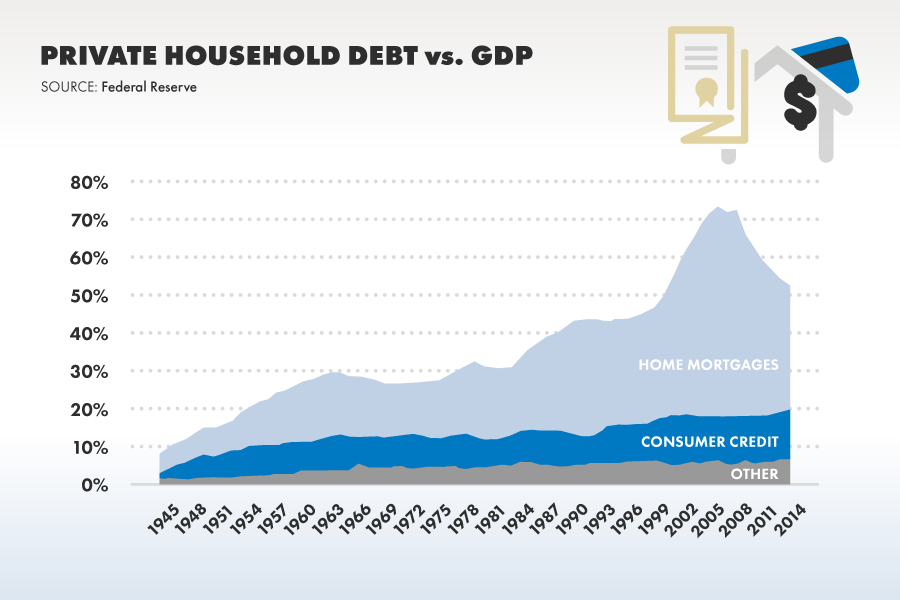
On top of the physical limits we are experiencing, we are facing further headwinds from financial markets. As a side effect of increasing consumption over investment, almost all economies have grown their financial obligations much faster than their income (measured as GDP). This is as if your own family gets deeper into debt each year, while your income grows much more slowly. And that’s exactly what has happened: On average, each household, each country, and each company today owes more, relative to their income, compared to 30 or 40 years ago. It is very hard to imagine that we can continue growing debt levels, particularly because we are already experiencing the lowest interest rates in history, which temporarily gave us more room to breathe by reducing the debt service burden on households, companies and governments. In the United States, households have already experienced these limits since the financial crisis of 2008, and overall credit availability for private individuals has shrunk. But without growing debt, the ability to invest and consume remains limited.
Adding renewable energy complicates things
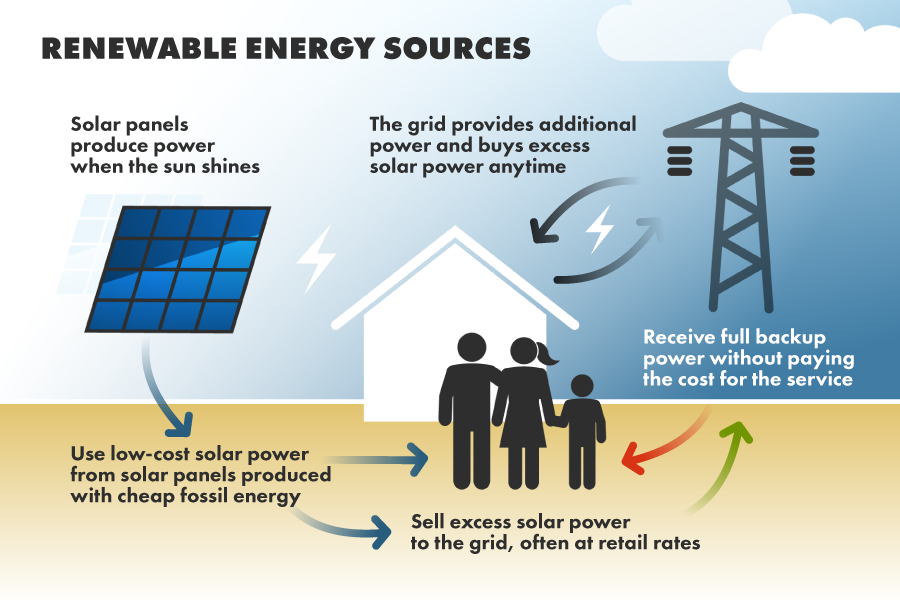
Many people hope that rising prices of natural resources and energy will benefit a transition to renewable energy sources. So far, introducing wind and solar - the two most relevant renewable alternatives - has only happened in places with large subsidies or government mandates or at least some imbalance in cost attribution of the overall system. For example, people who produce solar electricity on their roof at a rate that compares favorably to the power charged by their utility receive the reliability of the power grid for free, giving them as much electricity as needed at times when their solar panels don't produce enough. Often, their utility is also buying back excess solar energy at above-market prices. This works well as long as solar power (or wind turbines) have a relatively small market share like today, once everyone produces their own power when the sun shines, getting grid services for free is no longer feasible.This demonstrates a problem almost all energy sources that are driven by "current solar power" have versus those driven by "prehistoric solar power": the latter are available as stores, ready to unearth and to burn when we want to use them, whereas the former come with the weather, demanding a lot of extra effort to convert them into useful energy flows to our societies. Given these constraints, we consider it unlikely that current solar flows will ever become as beneficial as the easy fossil fuels we were burning during the 20th century.
This might also explain why we have - despite commitments to the contrary - been notoriously bad at adding renewable technologies. So far, in every year except for 2009, when the global economy and thus energy use shrank by 2%, total fossil fuel consumption grew faster than renewable energy use. If we continue to add renewable energy sources at the pace of the past 10-15 years, we will only reduce the share of fossil fuels from 86% of global raw (primary) energy consumption in 2015 to about 83-84% by 2050. If we try to do more, we will face problems with scaling up that will also impact the ability of our economies to grow.
The farm’s growth potential is exhausted

What is taking place today is rather simple: If we think back to our initial example of a farm, we are doing almost everything we can to increase crop output, but we are no longer harvesting heaps more every year as we used to. We can make big efforts, such as bringing in the latest machinery, even more fertilizer or more helping hands in order to squeeze out a little bit, but at a high cost and with unsatisfying results. And now, they are even taking some of our fancy tools and machines away.
Since 2008/9, nothing has been normal for economics, because we are at a point where growth becomes almost impossible. Compare it with when you have stretched a rubber band to its maximum length. Pulling it further becomes harder as the force against your pull is strengthening, and it is only a matter of which will give: you, because the rubber is stronger, or the band when it snaps. The best alternative is to recognize the situation and reduce the pull.
Our brain is looking backwards for guidance
When planning for the future, it has always been useful to look at the past for guidance. This has been great advice for most of human history, as throughout 99.9% of our 200,000 years on this planet, with the exception of the past 250, changes have been very slow to arrive, except for sudden events like natural disasters. Those hunters and gatherers who took the beaten path were much more likely to return home than those who ventured into the unknown parts of the jungle, looking for new discoveries and adventures. Out of 100 people who took the risk, one might have returned rich, while 99 never made it back.

For many people alive today, the dominating experience was that next year will likely be better than last, and that economic growth can be taken for granted. It requires true reflection, combined with a reach into our planet's history beyond the year 1750, to understand that our current experience has been shaped by the one-time benefits of burning 500 million years of solar power that will never return once they are used up.
Drivers behind our success: energy and natural resources
Cover Story 2/4

"Turning to dust" is a proverb accurately describing what happens with things over time. If we don't put effort into maintaining a car or a house, sunlight, wind and rain as well as the mechanical wear from their use, slowly but steadily turn them into a pile of rubble that is no longer useful. The term behind this process is called entropy. Or, to use another simple analogy: if we never clean up, at one point our living or working space will become a useless mess we can't even access, let alone find anything we might need.

To counteract this perpetual force of destruction, we have to put in hard work: repainting walls, replacing broken roof tiles, fixing a leaking pipe. And we clean up regularly, some more often than others, before chaos completely wins. Nature does the same: after a plant has died, a new one grows out of the ground, turning the disorganized molecules of rotting plant biomass into yet another beautiful and well-organized shoot.
What do all these efforts have in common? They require energy - for us to produce and apply the new paint, for the plant to grow. We need fuels to run a factory or food for our body, while the energy for plants is coming from a process called photosynthesis, the ingenious way of nature to turn sunlight into glucose that provides the energy to assemble new branches, leaves and flowers from molecules available in air and soil, assembling elements like carbon, hydrogen, nitrogen, phosphorus, oxygen, iron, and many more into life.
More activity means more energy and resource use
It may seem obvious and certainly was to our ancestors farming their land, but it's neither part of today's common sense nor anywhere represented in standard economic theory: every time we fight entropy and try to create order, we apply energy to organize resources into more organized forms. If we build a car, we need electricity and heat to convert raw materials into that shiny piece of human ingenuity, we need fuels to drive it, and energy for regular maintenance so it doesn't break down. And we even need energy to disassemble the vehicle at the end of its life and dispose of or recycle the parts. If we want two cars instead of one, the amount of energy needed is roughly twice as much. We can become a little bit better at building cars as we improve our manufacturing process, or a bit more efficient at retrieving or converting raw materials. There is - however - no way around using more energy for more units of economic output, irrespective of what kind of "more" we are doing.
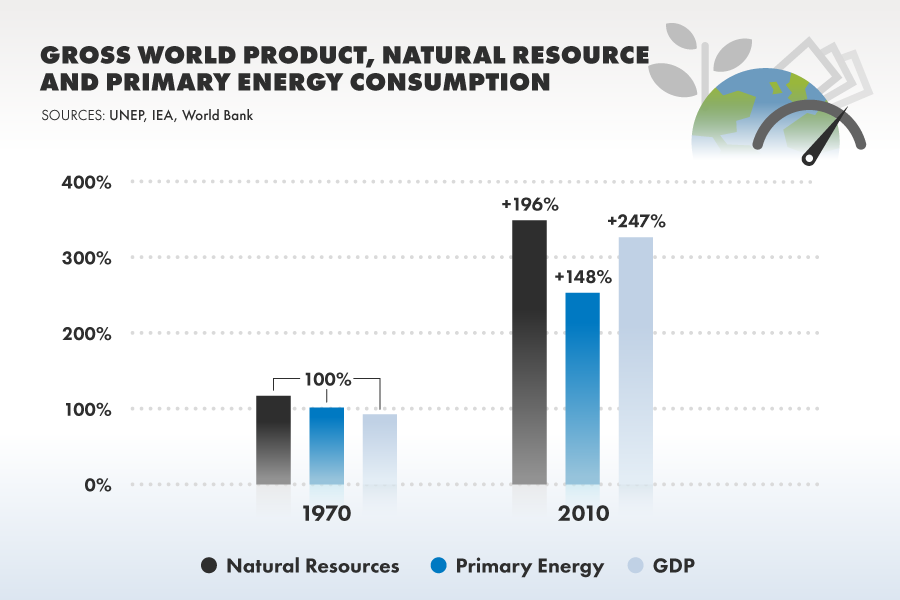
Over time, we can document that correlation well. Between 1970 and 2010, total global extraction of natural resources from our planet (fuels, ores, salts, biomass, etc.) is estimated to have grown 3.2-fold from 22 to 70 billion tons. During the same time period, the size of the world economy, adjusted for inflation, grew 3.4-fold from $18.9 to $65.6 trillion. For one additional unit of Gross World Product (GWP), we needed close to one additional units of natural resources.

When looking at energy, relationships look similar. Final energy use (electricity, or transportation fuels like gasoline and diesel) track the size of the world economy the same way as other natural resources. Until the first energy crisis in 1973, energy consumption and GWP were directly correlated - to achieve one more dollar of economic output, we needed 10.7 MJ of primary energy. After energy suddenly became more expensive, we managed to slightly reduce overall primary energy use per unit of GWP between 1973 and 2000 to around 7.9 MJ, by improving processing efficiency, particularly in electricity generation and the production of bulk materials like steel, aluminum and copper. Since the year 2000, our improvements have slowed down, as fewer large efficiency gains are left, and globalization has added more transportation needs to the economy: to achieve the same amount of GWP next year, we need 0.997 units of this year's energy. Should we continue at the same pace, doubling the global economy between 2015 and 2050 (which means 2% real growth every year) would require approximately 1.9 times (or 190%) of today's energy. This is if we are accurately accounting for GDP and inflation and are not overstating growth numbers.
For individual economies, these relationships are a lot weaker, as globalization has moved a lot of resource processing to low-cost countries. As most advanced economies have shifted from manufacturing things to importing energy and natural resources as parts of goods produced elsewhere, they seem to become more energy- and resource-efficient on paper, where in fact they are not. The processing just happens elsewhere, for example in China..
Photosynthesis, still the most important process for life and our energy systems
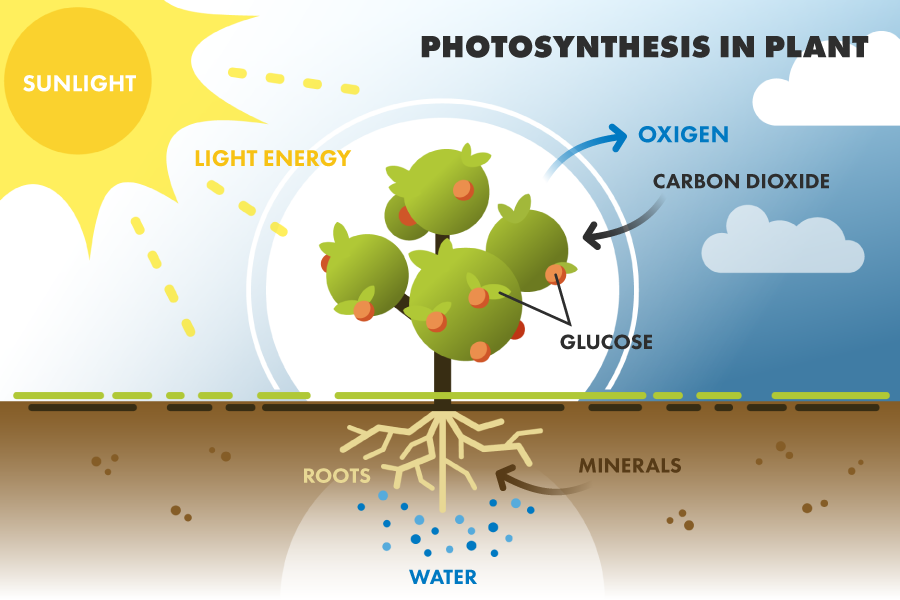
Where does all that energy come from? In 2014, over 90% of all the energy used by humans is the output of past and present photosynthesic plant growth. In 2014, total global energy consumption was 13,147 MTOE, where a small part (5%) from currently growing plant biomass, but mostly (85%) from fossil fuels like coal, natural gas and oil that represent nothing but ancient biomass stored underground during the past 500 million years.
For this conversation, it is important to understand that the sun fuels more than 95% of all energy use on Planet Earth, as wind and hydro power are equally driven by heat from sunshine moving air and water. The only sources that didn't require solar contributions during the past billion years are nuclear power (4.6% of global primary energy production in 2014) and geothermal energy (0.05%).
Our primary helper: prehistoric solar energy
During the industrial age, economic growth has mainly be attributed to our human prowess and ingenuity, ignoring that, without fossil solar power, it would simply have been impossible to convert all those resources into houses, cars, planes and mobile phones.
We are consuming those fossil stores of coal, natural gas and oil at a breathtaking rate: each year, we approximately use the quantity that took around 4.5 million years to form, or after 7 seconds into January 1 of each new year, we have used up what our planet took an entire year to produce. And all this energy was almost free for us during the past 250 years.
We used and still use fossil energy for all the things we do today. We extract minerals like copper, iron or silicone from the ground, we refine them, and turn them into products, like building materials, machinery, or computers. We transport these around the globe, and travel ourselves, we build, maintain and heat our factories, offices and living spaces. Also, we use this same fossil energy to grow food, as we have long moved away from simply growing what is possible on a given plot of land without fossil inputs. Current sunlight isn't enough to feed all 7.4 billion humans.
All these inputs are also used to create renewable energy infrastructure. Solar panels, wind turbines, and batteries are mostly manufactured by using fossil fuels to extract and convert natural resources into a final product. So far, we have achieved little: the share of fossil fuels in global energy consumption has dropped from 88% in 1985 to 86% in 2015. Ironically, in order to further accelerate that, we would need even more fossil fuels in absolute terms.

